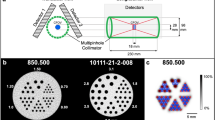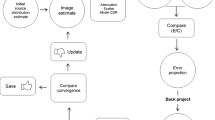Abstract
Objective
The performance characteristics of the SPECT sub-system S102 of the ALBIRA II PET/SPECT/CT are analyzed for the 80 mm field of view (FOV) to evaluate the potential in-vivo imaging in rats, based on measurements of the system response for the commonly used Technetium-99 m (99mTc) in small animal imaging.
Methods
The ALBIRA II tri-modal µPET/SPECT/CT pre-clinical system (Bruker BioSpin, Ettlingen, Germany) was used. The SPECT modality is made up of two opposite gamma cameras (Version S102) with Sodium doped Cesium Iodide (CsI(Na)) single continuous crystal detectors coupled to position-sensitive photomultipliers (PSPMTs). Imaging was performed with the NEMA NU-4 image quality phantom (Data Spectrum Corporation, Durham, USA). Measurements were performed with a starting activity concentration of 4.76 MBq/mL 99mTc. An energy window of 20% at 140 keV was selected in this study. The system offers a 20 mm, 40 mm, 60 mm and an 80 mm field of view (FOV) and in this study the 80 mm FOV was used for all the acquisitions. The data were reconstructed with an ordered subset expectation maximization (OSEM) algorithm. Sensitivity, spatial resolution, count rate linearity, convergence of the algorithm and the recovery coefficients (RC) were analyzed. All analyses were performed with PMOD and MATLAB software.
Results
The sensitivities measured at the center of the 80 mm FOV with the point source were 23.1 ± 0.3 cps/MBq (single pinhole SPH) and 105.6 ± 5.5 cps/MBq (multi pinhole MPH). The values for the axial, tangential and radial full width at half maximum (FWHM) were 2.51, 2.54, and 2.55 mm with SPH and 2.35, 2.44 and 2.32 mm with MPH, respectively. The corresponding RC values for the 5 mm, 4 mm, 3 mm and 2 mm rods were 0.60 ± 0.28, 0.61 ± 0.24, 0.29 ± 0.11 and 0.20 ± 0.06 with SPH and 0.56 ± 0.20, 0.50 ± 0.18, 0.38 ± 0.09 and 0.23 ± 0.06 with MPH. To obtain quantitative imaging data, the image reconstructions should be performed with 12 iterations.
Conclusion
The ALBIRA II preclinical SPECT sub-system S102 has a favorable sensitivity and spatial resolution for the 80 mm FOV setting for both the SPH and MPH configurations and is a valuable tool for small animal imaging.







Similar content being viewed by others
References
Franc BL, Acton PD, Mari C, Hasegawa BH. Small-animal SPECT and SPECT/CT: important tools for preclinical investigation. J Nucl Med. 2008;49:1651–63.
Khalil MM, Tremoleda JL, Bayomy TB, Gsell W. Molecular SPECT imaging: an overview. Int J Mol Imaging. 2011. https://doi.org/10.1155/2011/796025.
Seo Y, Jiang H, Franc BL. Preclinical SPECT and SPECT/CT, in molecular imaging in oncology. Heidelberg: Springer; 2013.
Beyer T, Freudenberg LS, Townsend DW, Czernin J. The future of hybrid imaging-part 1: hybrid imaging technologies and SPECT/CT. Insights Imaging. 2011;2:161–9.
Golestani R, Wu C, Tio RA, Zeebregts CJ, Petrov AD, Beekman FJ, et al. Small-animal SPECT and SPECT/CT: application in cardiovascular research. Eur J Nucl Med Mol Imaging. 2010;37:1766–77.
Vallabhajosula S. Molecular imaging. Radiopharmaceuticals for PET and SPECT. Berlin: Springer; 2009.
Glatting G, Bardiès M, Lassmann M. Treatment planning in molecular radiotherapy. Z Med Phys. 2013;23:262–9.
Hardiansyah D, Attarwala AA, Kletting P, Mottaghy FM, Glatting G. Prediction of time-integrated activity coefficients in PRRT using simulated dynamic PET and a pharmacokinetic model. Phys Med. 2017;42:298–304.
Jiménez-Franco LD, Kletting P, Beer AJ, Glatting G. Treatment planning algorithm for peptide receptor radionuclide therapy considering multiple tumor lesions and organs at risk. Med Phys. 2018;45:3516–23.
Attarwala AA, Karanja YW, Hardiansyah D, Romanó C, Roscher M, Wängler B, et al. Investigation of the imaging characteristics of the ALBIRA II small animal PET system for 18F, 68Ga and 64Cu. Z Med Phys. 2017;27:132–44.
Sánchez F, Orero A, Soriano A, Correcher C, Conde P, Gonzalez A, et al. ALBIRA: a small animal PET/SPECT/CT imaging system. Med Phys. 2013;40:051906.
Wirrwar AK, Nikolaus S, Schramm NU, Arkian S, Cohnen M. Müller HW [TierSPECT: performance of a dedicated small-animal-SPECT camera and first in vivo measurements]. Z Med Phys. 2005;15:14–22.
Spinks TJ, Karia D, Leach MO, Flux G. Quantitative PET and SPECT performance characteristics of the Albira Trimodal pre-clinical tomograph. Phys Med Biol. 2014;59:715–31.
Glatting G, Reske SN. Treatment of radioactive decay in pharmacokinetic modeling: influence on parameter estimation in cardiac 13N-PET. Med Phys. 1999;26:616–21.
Attarwala AA, Hardiansyah D, Romanó C, Roscher M, Molina-Duran F, Wängler B, et al. A method for point spread function estimation for accurate quantitative imaging. IEEE Trans Nucl Sci. 2018;65:961–9.
NEMA. Performance measurements of small animal positron emission tomographs. Rosslyn: NEMA Standard Publications; 2008. (NU 4).
Beekman FJ, van der Have F, Vastenhouw B, van der Linden AJ, van Rijk PP, Burbach JP, et al. U-SPECT-I: a novel system for submillimeter-resolution tomography with radiolabeled molecules in mice. J Nucl Med. 2005;46:1194–200.
Metzler SD, Bowsher JE, Smith MF, Jaszczak RJ. Analytic determination of pinhole collimator sensitivity with penetration. IEEE Trans Med Imaging. 2001;20:730–41.
Soret M, Bacharach SL, Buvat I. Partial-volume effect in PET tumor imaging. J Nucl Med. 2007;48:932–45.
Togawa T, Yui N, Kinoshita F, Yanagisawa M. Quantitative evaluation in tumor SPECT and the effect of tumor size: fundamental study with phantom. Ann Nucl Med. 1997;11:51–4.
Takahashi Y, Miyagawa M, Nishiyama Y, Ishimura H, Mochizuki T. Performance of a semiconductor SPECT system: comparison with a conventional Anger-type SPECT instrument. Ann Nucl Med. 2013;27:11–6.
Umeda IO, Tani K, Tsuda K, Kobayashi M, Ogata M, Kimura S, et al. High resolution SPECT imaging for visualization of intratumoral heterogeneity using a SPECT/CT scanner dedicated for small animal imaging. Ann Nucl Med. 2012;26:67–76.
Schramm N, Hoppin J, Lackas C, Gershman B, Norenberg J, de Jong M. Improving resolution, sensitivity and applications for the NanoSPECT/CT: a high-performance SPECT/CT imager for small-animal research. J Nucl Med. 2007;48:436P.
Deleye S, van Holen R, Verhaeghe J, Vanderberghe S, Stroobants S, Staelens S. Performance evaluation of small-animal multipinhole μSPECT scanners for mouse imaging. Eur J Nucl Med Mol Imaging. 2013;40:744–58.
Nikolaus S, Wirrwar A, Antke C, Kley K. Müller HW [State-of-the-art of small animal imaging with high-resolution SPECT]. Nuklearmedizin. 2005;44:257–66.
van der Have F, Vanstenhouw B, Ramakers RM, Branderhorst W, Krah JO, Ji C, et al. U-SPECT-II: an ultra-high-resolution device for molecular small-animal imaging. J Nucl Med. 2009;50:599–605.
Acknowledgements
The authors would like to thank the colleagues from Bruker Biospin GmbH, Ettlingen, Germany for the helpful discussions during the course of this research. This research project is part of the Research Campus M2OLIE and funded by the German Federal Ministry of Education and Research (BMBF) within the Framework “Forschungscampus – public-private partnership for Innovations” under the funding code 13GW0388A and 13GW0091E.
Author information
Authors and Affiliations
Corresponding author
Additional information
Publisher's Note
Springer Nature remains neutral with regard to jurisdictional claims in published maps and institutional affiliations.
Rights and permissions
About this article
Cite this article
Attarwala, A.A., Hardiansyah, D., Romanó, C. et al. Performance assessment of the ALBIRA II pre-clinical SPECT S102 system for 99mTc imaging. Ann Nucl Med 35, 111–120 (2021). https://doi.org/10.1007/s12149-020-01547-7
Received:
Accepted:
Published:
Issue Date:
DOI: https://doi.org/10.1007/s12149-020-01547-7




